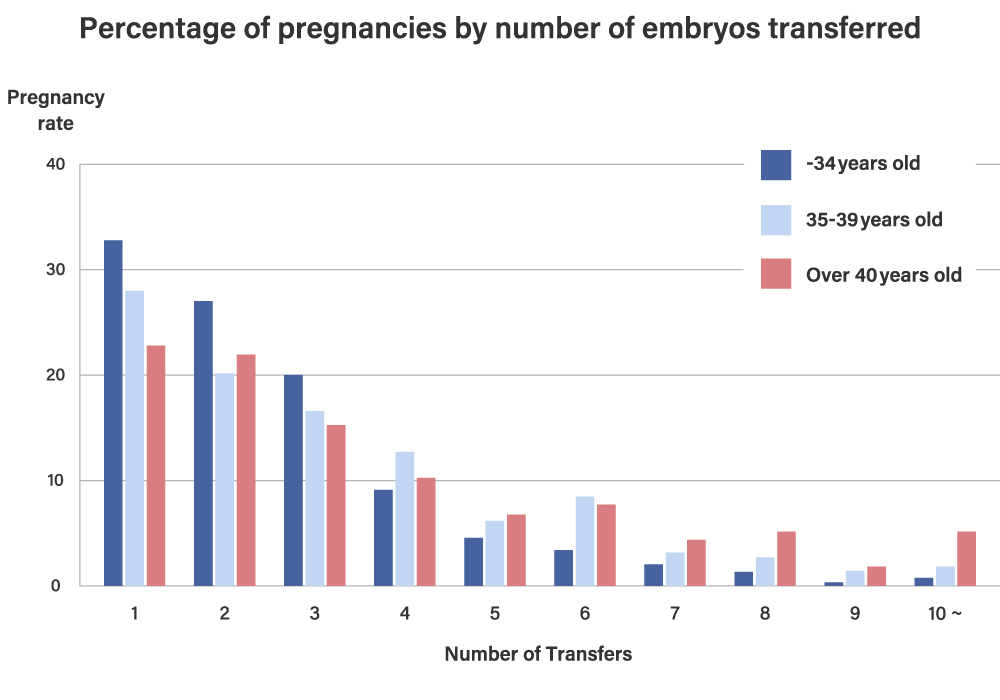Pregnancy rate of IVF
Pregnancy rates in frozen blastocyst transfer
A frozen blastocyst transfer is a procedure in which a fertilized egg is cultured for five to six days until it reaches a state called a blastocyst, frozen and preserved, and then transferred to the uterus in another cycle. There are four stages of embryo transfer:
1) Fresh early embryo transfer, 2) Fresh blastocyst transfer, 3) Frozen early embryo transfer, and 4) Frozen blastocyst transfer.
Of these, (4) Frozen Blastocyst Transfer has the highest pregnancy rate.
SCROLL
| Age |
The pregnancy rate when one embryo transfer is performed |
The pregnancy rate when two embryo transfers are performed |
| ~31 years old |
53.5% |
66.7% |
| 32~34 years old |
63.6% |
64.3% |
| 35~37 years old |
51.8% |
69.0% |
| 38~40 years old |
42.6% |
38.2% |
| 41~43 years old |
32.6% |
41.2% |
| Over 44 years old |
31.0% |
37.5% |
Pregnancy rate in embryo transfer method
There are three methods of embryo transfer: "hormone replacement," "natural method," and “minimum stimulus”.
Here are the pregnancy rates of each of these methods.
This data includes both single and double transplants.
SCROLL
| Age |
Hormone replacement |
Completely natural method・Minimum stimulus |
| ~34 years old |
62.5% |
30.0% |
| 35~40 years old |
49.1% |
22.2% |
| Over 41 years old |
32.7% |
30.8% |
Percentage of pregnancies by number of embryos transferred
Blastocyst Achievement Rate
This is the probability that a fertilized egg has developed into a blastocyst after five to six days of incubation.
The pregnancy rate for embryos that develop into blastocysts is high, so it is important to culture as many fertilized eggs as possible into blastocysts.
The blastocyst achievement rate is a guideline for evaluating a fertility treatment facility.
SCROLL
| Age |
Blastocyst Achievement Rate |
Good Blastocyst Achievement Rate |
| ~31 years old |
68.5% |
53.4% |
| 32~34 years old |
73.7% |
57.0% |
| 35~37 years old |
64.5% |
49.8% |
| 38~40 years old |
61.1% |
44.0% |
| 41~43 years old |
59.7% |
37.7% |
| Over 44years old |
43.1% |
20.7% |
In the case of time-lapse culture, the blastocyst achievement rate is improved by an average of 11% over the above.
*Good embryos of 4BC or more
Number of cycles
The number of egg collections and embryo transfers per year.
SCROLL
| Number of egg collections |
1327/year |
| Number of embryo transfers |
1348/year |
Pregnancy rate of Timed intercourse
and Artificial insemination
The results of Timed intercourse
Timed intercourse is a method that predicts a woman's ovulation date in advance and guides to the day of sexual intercourse when most likely to conceive.
SCROLL
| Pregnancy rate |
| ~31 years old |
Statistical processing is not possible because the total number is unknown. |
| 32~34 years old |
| 35~38 years old |
| Over 39 years old |
SCROLL
| Number of cycles |
| Average cycles to pregnancy |
2.5cycles |
| Minimum number of cycles to pregnancy |
1cycle |
| Maximum number of cycles to pregnancy |
15cycles |
SCROLL
| Age |
| Average age of implementers |
Unknown |
| Average age of pregnancies |
33.3years old |
| Minimum age of pregnancies |
24years old |
| Maximum age of pregnancies |
44years old |
SCROLL
| Multiple birth rates |
| Multiple birth rates |
Unknown |
The results of Artificial insemination
Artificial insemination is a method of injecting the husband's sperm into the uterus at the most fertile time by predicting the woman's ovulation date in advance.
In the case of the Timed intercourse, the sperm is ejaculated vaginally through sexual intercourse and enters the uterus by spermself, but artificial insemination can shortcut that part of the process.
SCROLL
| Pregnancy rate |
| Age |
1~3cycles |
4~6cycles |
Average |
| ~31years old |
6.3% |
8.0% |
6.8% |
| 32~34years old |
4.9% |
5.9% |
5.0% |
| 35~38years old |
8.1% |
7.1% |
7.8% |
| Over 39years old |
10.0% |
3.2% |
7.6% |
SCROLL
| Number of cycles |
| Average time to pregnancy |
3cycles |
| Minimum number of cycles to pregnancy |
1cycle |
| Maximum number of cycles to pregnancy |
16cycles |
SCROLL
| Age |
| Average age of implementers |
35.3years old |
| Average age of pregnancies |
34.9years old |
| Minimum age of pregnancies |
27years old |
| Maximum age of pregnancies |
42years old |
SCROLL
| Multiple birth rates |
| Multiple birth rates |
0.0% |


